Apple Announces 5nm A14 SoC - Meagre Upgrades, Or Just Less Power Hungry?
by Andrei Frumusanu on September 15, 2020 4:30 PM EST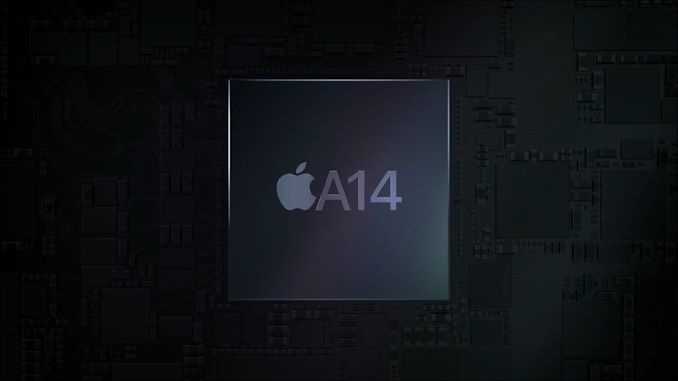
Amongst the new iPad and Watch devices released today, Apple made news in releasing the new A14 SoC chip. Apple’s newest generation silicon design is noteworthy in that is the industry’s first commercial chip to be manufactured on a 5nm process node, marking this the first of a new generation of designs that are expected to significantly push the envelope in the semiconductor space.
Apple’s event disclosures this year were a bit confusing as the company was comparing the new A14 metrics against the A12, given that’s what the previous generation iPad Air had been using until now – we’ll need to add some proper context behind the figures to extrapolate what this means.
On the CPU side of things, Apple is using new generation large performance cores as well as new small power efficient cores, but remains in a 2+4 configuration. Apple here claims a 40% performance boost on the part of the CPUs, although the company doesn’t specify exactly what this metric refers to – is it single-threaded performance? Is it multi-threaded performance? Is it for the large or the small cores?
What we do know though is that it’s in reference to the A12 chipset, and the A13 already had claimed a 20% boost over that generation. Simple arithmetic thus dictates that the A14 would be roughly 16% faster than the A13 if Apple’s performance metric measurements are consistent between generations.
On the GPU side, we also see a similar calculation as Apple claims a 30% performance boost compared to the A12 generation thanks to the new 4-core GPU in the A14. Normalising this against the A13 this would mean only an 8.3% performance boost which is actually quite meagre.
In other areas, Apple is boasting more significant performance jumps such as the new 16-core neural engine which now sports up to 11TOPs inferencing throughput, which is over double the 5TOPs of the A12 and 83% more than the estimated 6TOPs of the A13 neural engine.
Apple does advertise a new image signal processor amongst new features of the SoC, but otherwise the performance metrics (aside from the neural engine) seem rather conservative given the fact that the new chip is boasting 11.8 billion transistors, a 38% generational increase over the A13’s 8.5bn figures.
The one explanation and theory I have is that Apple might have finally pulled back on their excessive peak power draw at the maximum performance states of the CPUs and GPUs, and thus peak performance wouldn’t have seen such a large jump this generation, but favour more sustainable thermal figures.
Apple’s A12 and A13 chips were large performance upgrades both on the side of the CPU and GPU, however one criticism I had made of the company’s designs is that they both increased the power draw beyond what was usually sustainable in a mobile thermal envelope. This meant that while the designs had amazing peak performance figures, the chips were unable to sustain them for prolonged periods beyond 2-3 minutes. Keeping that in mind, the devices throttled to performance levels that were still ahead of the competition, leaving Apple in a leadership position in terms of efficiency.
What speaks against such a theory is that Apple made no mention at all of concrete power or power efficiency improvements this generation, which is rather very unusual given they’ve traditionally always made a remark on this aspect of the new A-series designs.
We’ll just have to wait and see if this is indicative of the actual products not having improved in this regard, of it’s just an omission and side-effect of the new more streamlined presentation style of the event.
Whatever the performance and efficiency figures are, what Apple can boast about is having the industry’s first ever 5nm silicon design. The new TSMC-fabricated A14 thus represents the cutting-edge of semiconductor technology today, and Apple made sure to mention this during the presentation.
Related Reading:
- The Apple iPhone 11, 11 Pro & 11 Pro Max Review: Performance, Battery, & Camera Elevated
- The Samsung Galaxy S20+, S20 Ultra Exynos & Snapdragon Review: Megalomania Devices
- TSMC Expects 5nm to be 11% of 2020 Wafer Production (sub 16nm)
- ‘Better Yield on 5nm than 7nm’: TSMC Update on Defect Rates for N5


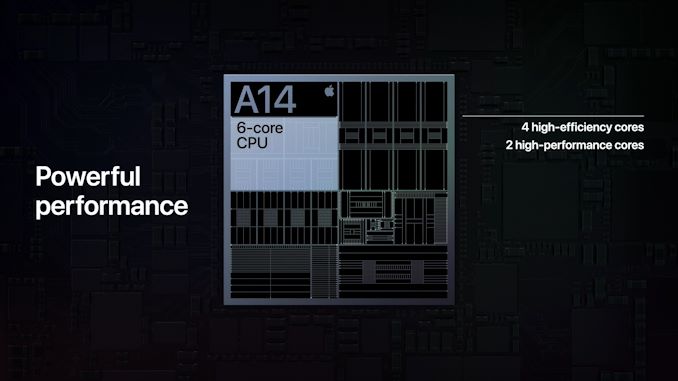
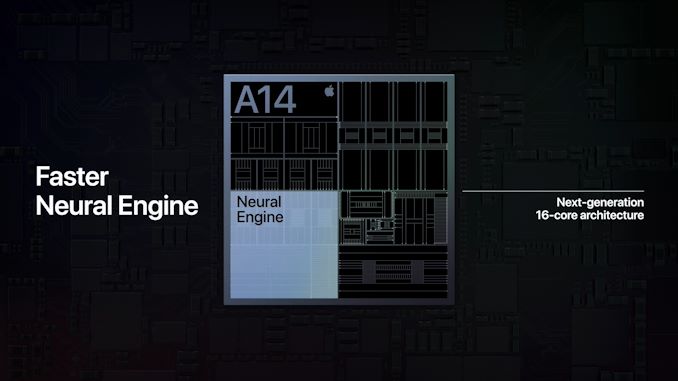
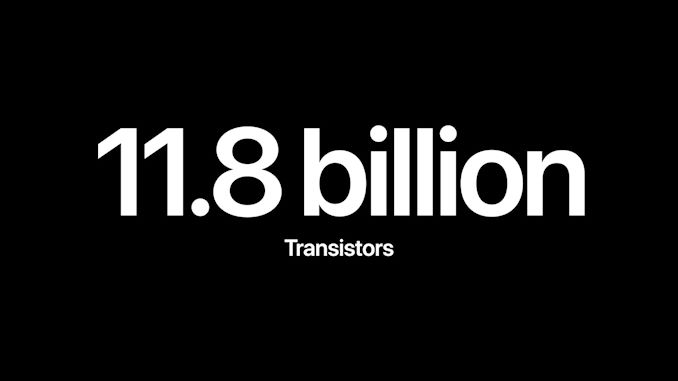
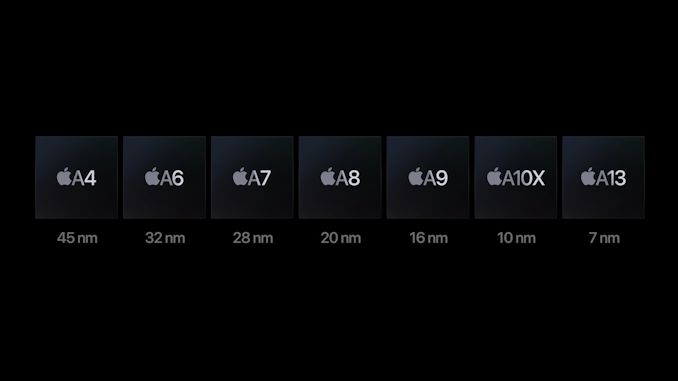








127 Comments
View All Comments
benedict - Tuesday, September 15, 2020 - link
Intel has been giving 5% performance upgrades each year since forever and people still bought billions of those chips. 16% CPU/8% GPU generation upgrade is nothing to scoff at.linuxgeex - Tuesday, September 15, 2020 - link
I think Andrei's reason for calling it "meagre" is because with the die shrink we could have expected similar gains without any significant architecture improvements... so this big exciting "40%" reveal feels a bit like they phoned it in when you take it in context of the A13 and the die shrink.Rudde - Wednesday, September 16, 2020 - link
To expand on your comment. TSMC N5 promises a ~15% improvement in performance compared to N7. Like Andrei mentioned, they might have improved their power efficiency at the cost of performance. What is strange is that Apple didn't mention better power efficiency. If A14 uses as much power as A13, then all the improvements come from the better node.OreoCookie - Wednesday, September 16, 2020 - link
I don't get Andrei's negativity here either. Your and his points are well taken, but I don't think it makes sense to jump the gun and say it is a meagre update. When I watched the presentation I thought to myself that Neural Engine is *massive*! Given Apple's tight integration of software and hardware I reckon Apple knows what it wants to do with it.nico_mach - Thursday, September 17, 2020 - link
It seems pretty slanted on first glance, and it's more than a little questionable given the situation around Intel's slow moving collapse and Apple's new initiative. I can't help but link the two, Intel has been noticeably underhanded and constantly getting caught.ChrisGX - Tuesday, September 29, 2020 - link
No, Andrei offers us an either/or: either the performance gains relative to the A13 are meagre (which might constitute an engineering failure) or Apple has become more concerned about the power draw of its mobile processors (which would indicate a change in design strategy). Unable to read Apple's mind he sensibly leaves it to us to make of this what we will. In the article what he says is: "Apple might have finally pulled back on their excessive peak power draw at the maximum performance states of the CPUs and GPUs, and thus peak performance wouldn’t have seen such a large jump this generation, but favour more sustainable thermal figures." That sounds like a positive statement to me that expresses support for the "pulling back" and the "more sustainable thermal figures" that it results in. Those Apple performance cores are already very potent (at peak performance). Even if I am wrong to read Andrei's words this way, I still think that would be the right strategy for Apple going forward. Just as ARM must be finding additional performance from its cores Apple needs to avoid overcooking things with its performance cores and thus rendering them unsuitable for use in a mobile device context.That said, Apple does have the most stunning power management tricks governing the operation of its SoCs. Even as delivered performance of recent A series SoCs (in the smartphone/pocketable device form factor) is tightly regulated and constantly shifting to sustainable levels (per the governing parameters of power draw and thermal envelope) what users of Apple phones notice is a product that offers great/responsive performance and good battery life in a package that seems to be free of compromise. Apple's smartphone SoCs are good enough to create that illusion and, not to take anything away from Apple, you need very good technology to create an illision like that. Still, illusions only take you so far.
If Apple's performance cores are going to genuinely rival the energy efficiency of licensed ARM cores (Apple doesn't seem to have cores with the incredible energy efficiency of ARM's licensed cores but conversely ARM doesn't seem to have on chip power management tech that is in the league of Apple's SoCs) and Apple should really want to do that because energy efficiency directly governs the relevance of a chip for use in the mobile context, then Apple is going to have to beat a path back to more energy efficient processor design. Such a processor might be a bit more conventional that Apple's recent A series offerings in that the sustained performance on tap would be more in line with the peak performance on offer from a chip. That doesn't mean that Apple should stop looking for performance gains from its smartphone silicon. It only means that it would make a lot of sense to put energy efficiency first for it forthcoming processors (for the smartphone). And, as there is already plenty of rarely tapped processing power that is nominally available from Apple's SoCs but that remains hidden from view most of the time, only showing up in peak performance favouring benchmarks like GB5, then pushing hard on an energy efficiency first SoC design strategy is, in any case, just one more interesting way and potentially a more fruitful way to explore how performance can be raised.
Retycint - Tuesday, September 15, 2020 - link
People were scoffing at Intel's performance upgrades too, just so you knowcha0z_ - Monday, September 21, 2020 - link
We talk about mobile space and mobile SOC's, it's bad regarding how things move here. Intel did 5% every year, because they didn't have any competition, they milked their buyers and saved a lot of R&D money.For it's size and new process, it's kinda laughable how small the uplift is, but hey! You got a lot faster ML that will be utilised by less than 1% of the buyers! Even the current NE/ML in A13 is not utilised at all. ARM promises big jumps in comparison, if A14 is really that small of an improvement as it's panning out - goes the drain is the 2 generation advantage that already is not really valid vs snapdragon 865+. Let's wait and see tho, I am really curious about the reveal + previous years we got already a lot of geekbench leaks of the new iphone, this year? hmmm
NextGen_Gamer - Tuesday, September 15, 2020 - link
Are we certain that the performance comparisons on the A14 were against the A12 from the previous iPad Air, and not the A13? That was unclear to me. During the presentation, when they started talking about the A14 chip, the speaker switched over to Tim Millet, Apple's VP of Platform Architecture. To me at least, I was assuming he was referring to the previous generation of A-series chips (A13), since he IS the A-series guy, and not just the previous iPad Air generation.And also, 38% more transistors seems crazy - is Apple hiding something? Is it really a 2+6 core CPU and 4-core GPU? Or is maybe 4+4 CPU and perhaps 6 or 8-core GPU? Apple disabling some parts on the iPad/iPhone 12, while enabling the full A14 for the first Apple Silicon Mac later this year?
Andrei Frumusanu - Tuesday, September 15, 2020 - link
> Are we certain that the performance comparisons on the A14 were against the A12 from the previous iPad Air, and not the A13?Yes, Apple is clear about it, that it compared to the past generation *device*. https://www.apple.com/newsroom/2020/09/apple-unvei...
It was also noted in the event.
As for transistors, bigger caches, double size NPU, probably new LPDDR5 controllers, probably fatter ISPs.